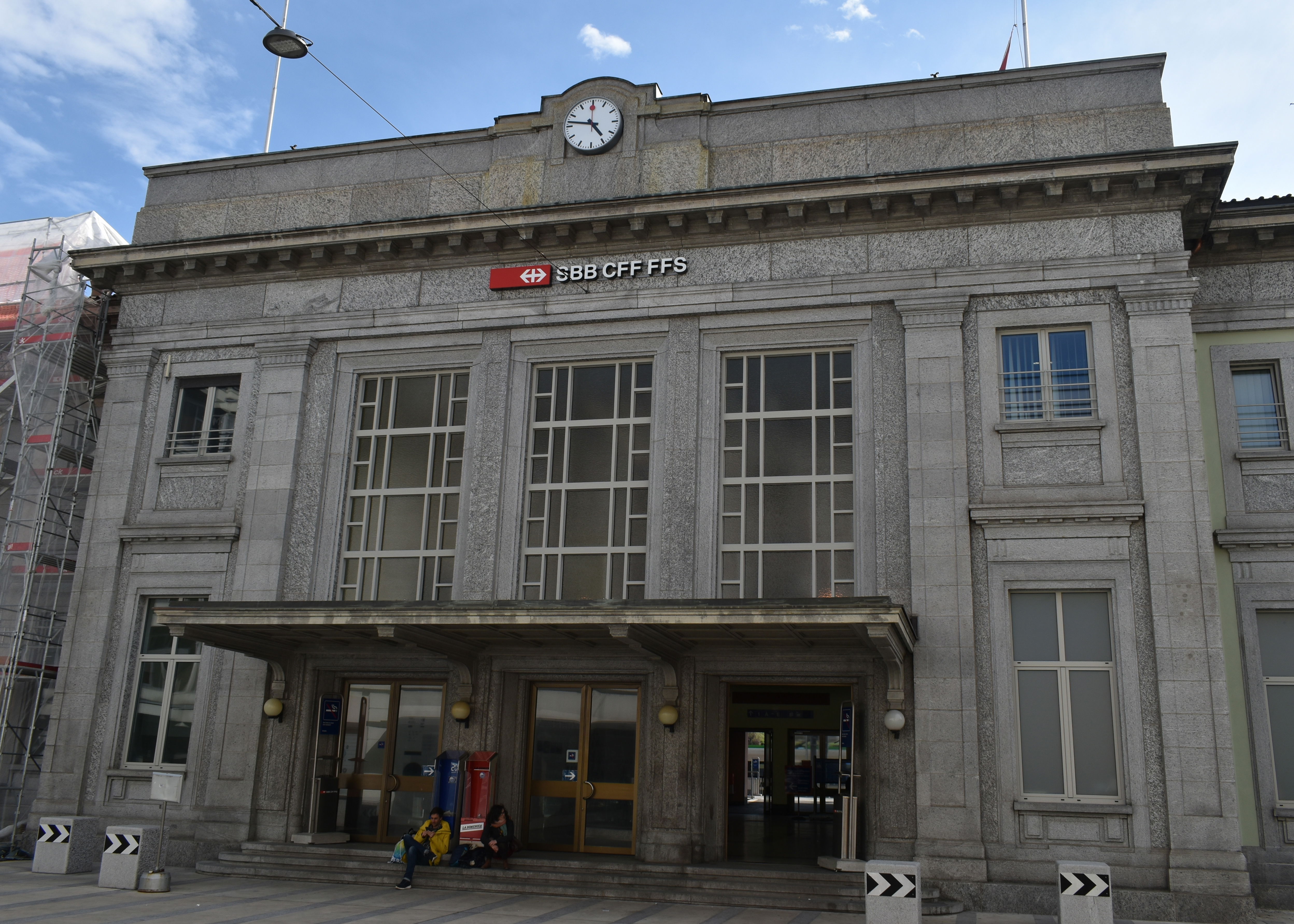Back on the Northern Front " Devils, angels and heroes on the Swiss border- by David Roberts
After a bit of a break, I have resumed explorations on the Linea Cadorna, the not entirely accurate name for Italy’s First World War Frontier defences. Having looked at the sector at the North of Lake Como at Fort Montecchio Nord and the sector around Porto Ceresio on Lake Lugano, this time . it is the well preserved sector along the Swiss border at Ponte Chiasso, which involves a pretty serious walk up about a thousand stairs.
To arrive by train from Italy, you will need a passport just in case. The walk starts in Ponte Chiasso on the Italian side . Ponte Chiasso does not have a railway station, so if you are arriving by train from Italy, you arrive at the Swiss Railway station of Chiasso. You exit the station . turning right and head downhill for the border which is about 200 hundred yards away. There is a fairly long queue for vehicle traffic, some of which are pilled over for searches- but pedestrians can just follow the pedestrian route without producing any documents. It is not entirely clear what the Customs are searching passenger cars for, it is one of the vagaries of Switzerland’s relationship with European Union. Although, not asked to show any documents , I was reading in a left behind Swiss newspaper on the train the other day , that there is an ongoing issue with illegal crossings – so there may be occasional random checks. Anyway, after a five minute sojourn in Switzerland it is back into Italy on foot.

The Italian-Swiss border from the Swiss side
I am trying to find the fortifications at Monte Sasso. These are high up in the hills in the Parco Spina Verde, which on the Italian side contains a maze of intersecting footpaths through the woods. But first you have to get up there- Things start well, the route is well signposted from the main road in Ponte Chiasso about 200 yards uphill from the border . A tunnel takes you under the railway line and out of the town, emerging in what appears to be some private parking space. At this point you might feel temporarily abandoned by the signpost, the road is blocked by a chain. But no fear, it is only to block vehicles and to the left you can easily spot the regular sign post which takes you uphill.

The stairway to heaven and the border fence
Uphill from here is with a lot of steps. The path is called the Scala del Paradiso, literally the stairway to heaven and there are apparently 900 steps in total . Fortunately, it is not one staircase , but a series of stairs, with a bit of walking in between and some spots to rest aching leg muscles and catch a breath. Incredibly there was one man running up and down them. The steps were constructed at the end of the 19th Century to give the Italian Finance Police an easier time in patrolling the border with Switzerland .They also gave the contrabanders operating on the border, an easier path to use when the Finance Police were not around. For most of the time, the stairs follow the border fence which is now in various stages of dilapidation and at times nonexistent. Although it seems easy to walk across, one assumes that there are Swiss border police occasionally lurking somewhere in the under growth.

"and she's buying a stairway to heaven"
In the Lake Como area, the main smuggling area was the border between Como and the Canton of Ticino, particularly the Intelvi Valley and the Upper Lake Valleys, Goods subject to monopoly or royalty, in particular salt, had been smuggled from Switzerland to Italy in the second half of the fifteenth century; however, it was the Napoleonic era that saw a boom in smuggling, mainly due to two factors: the promulgation of a-law with which the Napoleonic Italian Republic established monopolies of salt, tobacco and gunpowder, and the continental blockade decreed by the emperor of the French against English goods.
After the creation of the Swiss federal state in 1848 and the unification of Italy under the Savoy monarchy. . activity was again stimulated by the differences in tax and customs regimes, above all the Italian fiscal and commercial monopolies on certain goods. In addition to making illegal importation advantageous by, these practices generated distrust and hostility among the population in the border areas against a central state perceived as a foreign body, capable only of imposing heavy taxes. Networks of solidarity and mutual local economic interest were created among the Italian-Swiss populations of the border bands.. The Comasci had more in common with the Ticinese than they did with the government in Rome. For the inhabitants of the Italian border areas, smuggling was an accessory activity, illegal but socially and morally accepted. Since smuggling only damaged the Italian treasury, the Swiss customs authorities usually showed tolerance towards an activity that stimulated Swiss exports. Swiss border guards only asked Italian smugglers to announce their presence on Swiss territory at a customs post. The goods smuggled into Italy in the first half of the 20th century were mainly coffee, sugar, tobacco and stock cubes. At the time of Fascism, smuggling rings also served to introduce anti-fascist propaganda pamphlets and leaflets into Italy, which since this didn't break any Swiss law, was allowed to continue.
Smuggling came to a halt in the first phase of the Second World War, due to a stricter control of the borders, but also because in 1939, as part of the so-called war economy measures, Switzerland decreed a ban on coffee export. Smuggling, made a comeback in the final phase of the war, reversing the flow of goods for a few years. Between the end of 1943 and the autumn of 1947 there was what was called the "age of rice". Due to the Italian inflationary spiral and the strong depreciation of the lira against the franc, in order to obtain hard currency, the Italians preferred to divert various foodstuffs towards smuggled exports. The other driver was of course, the risk of sequestration by the occupying Germans. Italian farmers , prepare to take the risk of smuggling to Switzerland, rather than have their goods seized by or bought at a low price by the occupiers . Often the Italian farmers built up a network of trusted clients in Switzerland. The phenomenon mainly concerned rice, which was in great demand on the Swiss market due to rationing. however, goods of all kinds were smuggled to Switzerland: flour, socks, truck tyres, accordions and even condoms. Presumably quite a bit came from American army supply dumps. These same smuggling channels were used for refugees. Since the Germans were trying to stop the outflux of refugees and the Italians to hang onto scarce food supplies, the border became a lot more dangerous at this time.
The era of rice ended in 1947, when the inflationary spiral was broken in Italy and Switzerland abolished rationing. Smuggling resumed its usual direction and experienced a period of prosperity until the end of the 1960s, marked by the illegal export of blond cigarettes from Switzerland to Italy, as well as, to a lesser extent, coffee and watches. The Swiss authorities accepted a trade that damaged the Italian treasury but which contributed, among other things, through a tax on tobacco, to the financing of the Swiss social security system. By 1960 the value of smuggled goods accounted for almost a quarter of the value of legal exports from Switzerland to Italy; cigarette smuggling alone drove tens of millions of francs into the coffers of the Swiss social security institution every year. Presumably, Switserland Almost all of this traffic departed from the Canton of Ticino, The last hurrah of large-scale smuggling in the region ended around 1970, after a substantial increase in the price of cigarettes in Switzerland and a sharp devaluation of the lira.

More of the Scala del Paradiso
Having reached the top of the stairway to heaven, we are faced with the problem of finding the Fort. Fortino Monte Sasso or Fortino Cavallasca ( everything in Italy, seems to have at least two alternate names, is a quadrilateral fort around the base of a small hill, approximately 200 m by 50 m.. the Fort and the hill dominate the Chiasso Valley, or the Ticino salient the northerly route along which invaders might be expected to come . However, it is also arranged to defend against attacks from the West and East.

A pretty good gun position for shelling the Swiss
Around the base of the bill are a series of trenches, firing positions, gun emplacements and bunkers . The Italian engineers must have had to dig and blast there way into the underlying bedrock, on which they then poured copious amounts of concrete. The trench line follows a zig zag pattern to guard against enfilading fire and blast damage. The line is broken by emplacements for mortars , light artillery and machine guns , which were fully protected on al sides. Within the complex , there a number of small and large galleries to provide shelter for the mean and to act as first aid posts. Although no longer visible, these were ventilated with metal chimneys. Substantial ammunition dumps were kept further away. The inside of the trenches are lined with small square compartment for storing reserve ammunition and personal effects, which is a sort of Italian attention to detail. . It is all well planned and executed. Having been abandoned the system has now been restored by local volunteers.

"The things they carried" - some well designed cubbyholes for spare ammunition, personal effects and matbe a pack of ciggies
Of course the defences were not actually but to keep out the Swiss. Although Italy was a member of the Triple Alliance ( the Central Powers) before the war , there was always the fear that either Austria- Hungary or Germany or both would seek to invade Italy through Switzerland. It would have proved a formidable obstacle. In 1911 the Swiss Army consisted of around 250,000 ,men with a further 200,000 in reserve and support roles. The Germans had briefly mulled over violating Swiss neutrality and invading France through Switzerland but due to Switzerland’s better armed and organised forces and the mountainous topography, they had elected to attack rough Belgian instead . Following the various declarations of war, the Swiss mobilised, but kept most of their forces on the French border, even after Italy entered the war on the Entente side. By September 1914, it became clear that nobody had any intention of purposefully invading Switzerland . Although accidental incursions incurred on the mountain front between Italy and Austria- nobody ever invaded. The Swiss were providing a vital role as protecting power for Allied and German Prisoners of War ,and were hosting some 68,000 wounded French, British and German PWs There was really no incentive for anybody to invade. When they realised this, the Italian began to scale down their Swiss border defences and following the rout at Caporetto in 1917, most Italian forces were withdrawn to the Piave Front.
So the Northern Defence Line proved to be in military terms a White Elephant, extremely expensive to construct and never used. In Dino Buzzati’s famous Italian Novel “ The Tartar Steppe”, a group pf soldiers are stranded in a hill fort, waiting for an enemy that never arrives, it was probably a bit like that. After the First War, the line fell into disuse and the territory was reclaimed by nature. In World War 2, the main threat to Switzerland was either from the Germans invading to get to France or Italy or the German Armies trapped in Italy attempting a fighting retreat through Switzerland. In the event nothing happened.
Having toured the ruins, it was tine for a spot of refreshment; however there is a distinct lack of refreshment up in the park, so I have to find my way to the village of Cavallasca, and go into town to find somewhere for a snack. There is actually a road down on that side, I imagine it was also used to transport supplies up to the fort. So if you don’t want to climb the 900 steps from Chiasso and you have a car you can park at Cavallasca and access the Park and the Fort much more easily from that side. I did no , so I had to go back up the hill. To avoid walking don the steps , I was trying to follow an alternative roue down to Monte Olimpino and walk back to Chiasso from there . It did not happen. Although following the path for the Tibetan Bridge and Monte Olimpino. I reached the Tibetan Bridge and all signs for Monte Olimpino disappeared . In the end, I managed to find a path down, which was obviously a mountain bike path rather than a footpath, thankfully it joined up about half way down the stairs- so in only had to go down 450 to get back and emerged in Ponte Chiasso.
There is little of interest in Ponte Chiasso, it is a fairly normally run down Italian town without the glamour and excitement of a border town . Definitely not Ciudad Juarez to Chiasso’s El Paso, or vice versa. Although due to some rather more tolerant Swiss laws in certain respects , Chiasso may apparently be Ciudad Juarez for Italians. Ponte Chiasso has a couple of change bureaus, hairdressers and a butchers shop and Italy’s last pub. Anywhere else they might have made more of it with flags ,souvenirs and Tee Shirts, but Italy’s last pub before the border is resolutely normal. Not even a sign saying “Last chance to pay Euro 4,50 for a beer”. Over the border , the equivalent is maybe eight or nine euros.

"The Last Pub in Italy"
Anyway Ponte Chiasso/ Chiasso has an interesting history as a border town and some very courageous residents , which are worth reflecting on. In the last days of the war , the border at Ponte Chiasso saw numerous comings and gongs , connected with negotiations between the Allies and German representatives in Italy. Senior SS officials ditched their uniforms and crossed into Switzerland in plain clothes. Among those who crossed covertly at Chiasso was Karl Wolff, on his way to conduct secret negotiations with the Americans in Switzerland, as part of Operation Sunrise. As negotiations progressed. Italian prisoners were mysteriously released at the border and allowed to walk into Switzerland, these included future Italian Prime Minister Ferruccio Parri, suddenly freed from San Vittore prison and let across the border as part of a deal between Wolff and Allen Dulles, the Head of the OSS in Switzerland. All this took place and was indeed facilitated by the watchful eyes of the extremely neutral Swiss Intelligence Services. These days the border is open, albeit with the occasional stops. Looking at old photos, there used to be a gate. One can only imagine the relief for prisoners as the gates were opened and they were able to cross the border and enjoy their first taste of freedom for months,

The border from the Italian side in the 1930s
The border at Chiasso was the scene of some dramatic events in the last days of the war. On 26 April, with the game obviously up , the frontier guards of Mussolini’s Italian Social Republic (RSI) had abandoned the Italian post at Ponte Chiasso and been replaced by the partisans of the national Liberation Committee (CLN), the flag of the RSI had been lowered and replaced by the Italian Tricolor. Meanwhile the entire German border force at Ponte Chiasso had crossed over to Switzerland to be interned. By 27 April matters began to get more tense. Although the RSI had effectively collapsed, substantial German forces remained in the area. Usually the Germans preferred to surrender to the Allies rather than the Italian partisans, so although the CLN Partisans firmly controlled the area , militarily the Germans were still to be reckoned with. A column of some 200-400 Germans from Como, comprising Kriegsmarine, Wehrmacht and some SS troops turned up in the piazza in front of the Customs. Small groups of Germans had previously been allowed across the border to be interned and the Swiss admitted a column of wounded Germans evacuated from the Luftwaffe hospital in Cernobbio; however, this time the Swiss Federal Council in Bern, refused to let such a large group of armed Germans cross the border internment. The Germans therefore started to threaten to cross into Switzerland by force and matters became increasingly tense.
At 22.00 with the situation threatening to spiral out of control , the commander of the Swiss 3rd Army at Lucerne, Colonel A Constam ordered Colonel Mario Martinoni to head for Chiasso with reinforcements and take control of the situation. Martinino found a chaotic situation at Chiasso. He organized the evacuation of civilians from the via San Gottardo, the main road from the border- ( now a pedestrianised shopping street) and began to create defensive positions in case the worse happened. At dawn on 28 April, Martinoni sent another message to Bern , requesting permission to let the Germans into Switzerland having previously been disarmed. This was again refused. With the situation worsening, Martinoni now understood that the Americans had arrived in Como the previous evening and sought permission to speak to them. He was instructed to send some English speaking officers, but also elected to go himself. Setting off with to other Swiss officers in a car flying both Swiss and white flags, they arrived in Como and after searching at the Prefecture and the stadium, found the HQ of the American 13th Armoured Regiment , which had taken over the Hotel Metropole Suisse, recently vacated by the Germans. The US command sent Major Joseph McDivitt back to Ponte Chiasso with Martinino, followed by a column of armoured cars. which waited at Monte Olimpino on the road to Chiasso just in case. McDivitt, Martinino and the Swiss Consul Brenni, parleyed with the Germans assuring them that they would be sent to US prison camps and that there was no chance of being sent to the Soviets Union. At that point the Germans agreed to surrender and started to hand over their weapons. The Americans who had fought their way, from the beaches of North Africa, Salerno and up the Italian Peninsula had now reached the Swiss Border.

Mario Martinoni- the Swiss Colonel who saved Chiasso !
Martinoni’s actions undoubtedly saved Chiasso from a pointless bloodbath in the last days of the war. Unfortunately his commander did not see it quite like that. Consam, who apparently already had bad relations with Martinoni going back a few years accused him of being absent from his post without orders ( despite him following the verbal orders of the Federal Council) . Martinoni was removed to administrative duties and his Ticinese troops replaced by supposedly more reliable Swiss Germans. It was to be some 60 years before Martinoni’s reputation was restored. A monument just outside the Customs area was erected in his honour and a by then nonagenarian Major McDivitt was also feted by the residents of Chiasso.

The memorial for Martinoni in Chiasso
The Italian side of the border produced its own heroes and heroines. The via Vela runs parallel with the border and is about the last street in Italy . Following the Italian Armistice on 8 September 1943, an allotment on the via Vela became an escape route across the border organised by the angels of Ponte Chiasso The Regia Guardia di Finanza ( The Finance Police) in Chiasso gave rise to a small resistance cell, which helped with Jewish migration and aided the resistance. The group included Giovanni Gavino Tolis, his superior Marshal Paolo Boetti and a local woman Giuseppina Panzica.
Tolis was born in Sardinia in 1919, after graduating from elementary school, he worked for a few years as a farmer, before enlisting in the Regia Guardia di Finanza. On 1 June 1939 he was assigned to the Chiasso International Border Brigade, operating directly in Swiss territory. After the armistice of 8 September 1943, he worked for the resistance and trying to escape from the Germans to Switzerland. Tolis helped to deliver confidential letters and messages to and from Switzerland for partisan organizations such as the Fra. Ma Group of the C.L.N.A.I. (Comitato di Liberazione Nazionale Alta Italia), also assisting in the expatriation of Jewish refugees. In April 1944 he was placed under strict surveillance by the Command of the German Border Police, to which he had been reported by the Gestapo on 24 April, he was discovered passing a message to Mrs. Giuseppina Panzica.

The heroic Finance Policeman Giovanni Gavino Tolis who paid with his life for doing the right thing
Giuseppina Panzica, was born in Caltanissetta, Sicily in 1905, she was mother of four children and wife of a retired Finance Policeman Salvatore Luca. She joined the Fra. Ma Group, (an acronym of the surnames of Ezio Franceschini and Concetto Marchesi, two academics from the University of Padova) The Luca family met Tolis as early as September 1943. The Italian-Swiss border passed right through Salvatore Luca’s vegetable garden at via Vela no. 1. After retiring from the Finance Police, Salvatore had become a cobbler, he was the target of the local fascists not only for having helped the expatriation of Jews, but also for his anti-fascist conduct. In the days following Mussolini’s fall from power on 25 July 1943, he had collaborated in the destruction of the emblems of the ceased regime on the Casa del Lavoro in via Bellinzona. After the institution of the RSI he was under suspicion by local fascists and unable to find any work locally, so was forced to go to Germany.

Mrs Giuseppina Panzica- a very brave lady who managed to survive the camp at Ravensbruck and return to Italy
The agents of the Fra. Ma ensured supplies to the partisan brigades operating in northern Italy and, and the expatriation of anti-fascists and Jews. They also delivered the letters, currency, confidential documents, and messages into the hands of Tolis, who, through Mrs. Panzica, then oversaw their passage across the border. Even when Giuseppina was left alone in January 1944, when Salvatore went to Germany, together with her eldest sons Ignazio and Alfredo, Giuseppina continued her humanitarian work while looking after her two youngest children. In April 1944, both Tolis and Giuseppina were reported to the German counterintelligence, probably on an anonymous tip. So on April 24, 1944, Tolis was caught in the act near the Luca family garden, passing two packages which contained a total of 234,000 lire to the. Giuseppina. Tolis was subjected to a house search where an incriminating letter addressed to a Oscar Orefice in Lugano which mentioned some illegal border crossings by Jewish fugitives, was discovered. Both Tolis and Panzica were arrested by the Cernobbio SS Command the following day, Tolis was imprisoned in Como , then San Vittore prison in Milan, then transferred in succession to the concentration camps of Fossoli, and Bolzano. and to the extermination camp of Mauthausen,, where he died due to the ill-treatment to which he had been subjected. on 28 December , 1944. Giuseppina ended up in the female camp at Ravensbrück and fortunately survived to return to Ponte Chiasso. in October 1945 after a long stay in allied hospitals,
The Guardia di Finanza were accused of being complicit in aiding the escape of anti-fascists and Jews both by the Prefect of Como Francesco Scassellati Sforzolini and by the German border police. Scassellati Sforzolini, in a memorandum dated 22 February 1944 sent to the Questore of Como, wrote:
«The influx continues, mostly Jewish, who cross the border. The meeting place is in via Brogeda, from where, at dusk, they pass the border; passages with particularly heavy luggage have been noted. On the stretch of border that runs from the post office of Ponte Chiasso, into the countryside and up to the Maslianico bridge, surveillance, after dark, becomes very relative. The Guardia di Finanza help illegal passages».
Another helper was Tolis’s superior, Marshal Paolo Boetti, who also ended up in Mauthausen. At the time of the Armistice Marshal Boetti was interim commander at Torrigia on Lake Como, involving some colleagues of the Brigades in the activities of rescue work. Their work came to the attention of the fascist authorities of Como. The Commander of the Guardia in Milan, Colonel Alfredo Malgeri who was Boetti’s ultimate superior was also deeply involved in resistance activities. In order not to compromise his whole clandestine organization he had to arrange the transfer of Marshal Boetti to the Chiasso International Brigade. In fact , the Guardia di Finanza proved particularly committed to rescue and resistance work, being thoroughly distrusted by the Fascists and the Germans as a result.

Marshal Paolo Boetti- the third "Angel of Chiasso" who survived Mauthausen Camp
Boetti started in Chiasso on 27 January 1944, leaving his family in Torrigia but still did not abandon his support the forces resistance continuing to collaborate with the CLNAI and working as a "postman" on behalf of the partisans. In the spring of 1944, probably also on the basis of an anonymous tip, Boetti was reported to the German counterintelligence and subjected to careful surveillance by them. On 10 May, while on his way to work he was stopped by German customs officers. They found the sum of Lire325,000 that Paolo Boetti was supposed to deliver to Vittorio Levi, a refugee in Switzerland. .On 26 May after a month spent in Cernobbio, in the SS barracks and in the San. Donnino prison in Como, is transferred to the San Vittore prison in Milan. on June 9, 1944, found guilty of having compromised with the Resistance and with clandestine expatriations, and sentenced to deportation to Germany. First stop was Fossoli and then 21 June 1944, to Mauthausen, where he remained in forced labour until the Liberation of the camp on 4 May, 1945.

Aldo Pacifici- decorated war hero, public servant . Deported to Auschwitz for being Jewish
Less fortunate was the former head of the Dogana ( the Customs) in Ponte Chiasso. Aldo Pacifici. Aldo was Jewish. He lived on via Brogeda 11, the aforementioned meeting point for forays across the border. Aldo had served Italy in the Firsy World War as part of the Arditi ( shock assault troops) and had been wounded twice. He rose to be head of the Customs in Ponte Chiasso, before as a result of Italy’s 1938 Racial Laws, he was dismissed from the Civil Service. Although the Racial Laws were introduced by the Fascists, they were signed off by the King, so the vote for a Republic the anniversary of which falls on 2nd June was richly deserved. If as a result of the Racial Laws, Aldo was unable to continue as a Civil Servant, he was still able to work in other fields and not at risk of being murdered. Until, the 8 September when the Germans arrived at the border and their Fascist allies in the RSI , began to assist in rounding up the Jewish population. Aldo made it as far as Ponte Tresa on the Swiss Italian border at Lake Lugano before he was picked up. He was taken to the De Cristoforis barracks in Como where he might have had the opportunity to escape apparently he chose not to do so, to not cause problems for his son who was serving in the Army. Even when he was taken to the Transit Camp Fossoli, he continued to have faith that some Italian respect for legality might help him out. It did not, he was deported to Auschwitz and murdered arrival on 6 August 1944. He is commemorated by a Stolperstein outside his former residence in via Brogeda, 11

Aldo Pacifici's house on via Brogeda

The memorial Stolperstein
So having taken in a bit of the sad, dramatic and heroic story of some of the residents of Ponte Chiasso , we get back to the International Station for a train back to Italy. Despite a few knocks during the war and a lot of restructuring, it is still partly the old 1920s station. The station from which a not so well disguised head of the SS in northern Italy, took a train to meet with the Americans in Zurich in April 1945 and negotiate the surrender of German forces in Italy.

Chiasso International Station
By that stage , although being in neutral Switzerland, the station at Chiasso had been hit by a couple of Allied Air attacks . On 21 -January 1945, six America fighters machine gunned a steam train manoeuvring at the station Unfortunately the driver was killed, and the engineer injured . The same planes had earlier been shooting up the railway station at Como and had followed an Italian train which was hidden in nearby tunnels, Possibly the incursion happened because heavy snowfalls had covered the ubiquitous Swiss flags painted on the rooftops. A second attack, which might have been more targeted damaged three locomotives , 20 wagons and various infrastructure , but the station survived.
In the atrium of the station, is a statue representing Switzerland and Italy, reflecting all the difficulties of being a border town.

Svizzera and Italia- possibly more in common across the border than with rest of ther countries